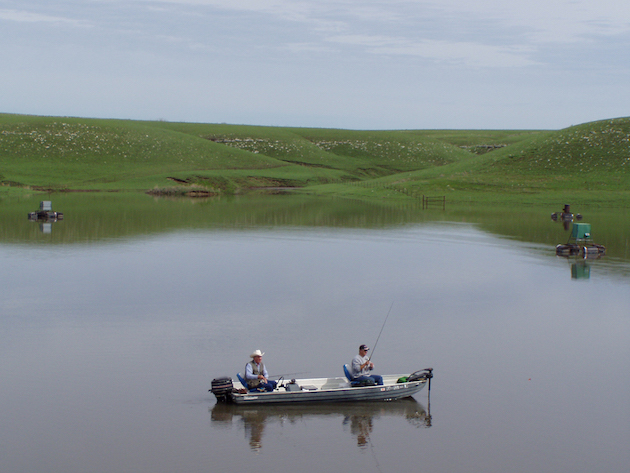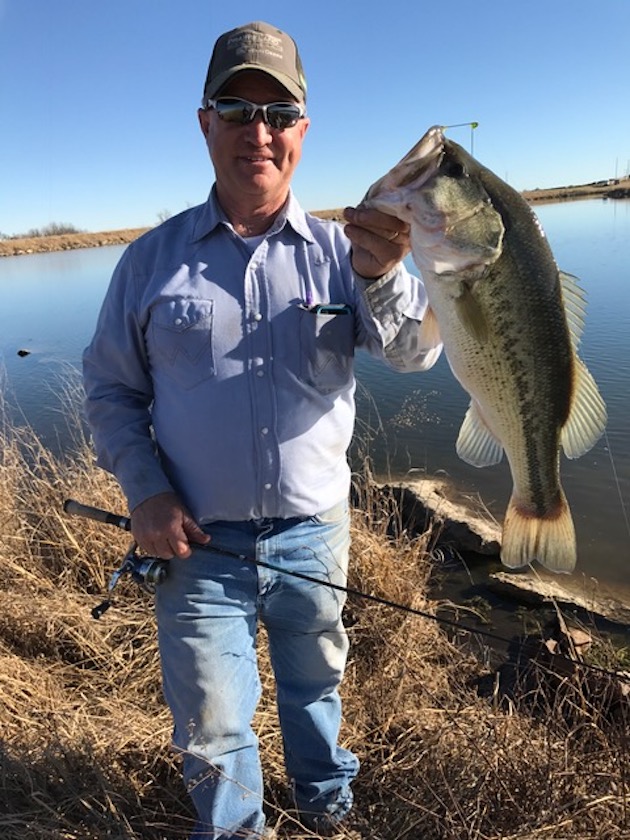Less than five percent of the prairie that once existed in the United States remains, and a big chunk of that can be found in Keith’s backyard.
Keith, 55, lives in a place some people might label “the middle of nowhere.” His cattle ranch in Lyon County is surrounded by tallgrass prairie left untouched over the ages. And that makes it a special place in Keith’s eyes.

Rod Moyer (left), shown fishing with Marc Murrell, has carved out a piece of paradise in the Flint Hills by creating an extraordinary lake.
“A lot of this land has never been turned under (by plows) because it’s so rocky,” Keith said as he looked over the expanse of grassland. “It’s been left just the way it was 100, 150 years ago, and you won’t find many places like that anymore. I can’t think of a better place to live.”
Keith realizes that not all people think that way. Some look at the Flint Hills as monotonous wasteland—drive-by country off Interstate 70. But Keith says they need to take a closer look.
“I’ve had people from the East Coast who will come out here, and they’ll say, ‘How can you live out here? You’re isolated,’” said Keith. “Then they’ll ask, ‘What do you do about your groceries?’
“But I tell them that we have three grocery stores within 17 to 20 miles of us. I can get there just as fast as they can get to their nearest grocery store in the city by the time they go through all of the stoplights. And our route is one heck of a lot more scenic than the ones they travel.”
If that sounds like someone who is enamored by life on the prairie, so be it.

Big bass lurk just below the surface of this man-made body of water.
Keith runs a large cattle business in the Flint Hills and lives close to the land. He looks forward to each spring, when the sounds of prairie chickens on their booming grounds carry across the prairie, when wildflowers start booming, when the bass and crappies in the pond he built start biting.
This is a land of plenty for wildlife. On any given day Kieth and his family will see flocks of wild turkeys cross the prairie, big deer bound across through the grass, and colorful songbirds flit from spot to spot. In late winter they’ll see ponds in the area packed so full of migrating snow geese that you’d swear there wasn’t room for one more bird.
“I wake up each morning from April to October and can go out the back door and see a new type of plant coming up,” he said. “It’s amazing how diverse plant life on the prairie is.”

Keith’s cattle keep him in the saddle and close to the land much of the time.
Keith decided at a young age that he was destined to be spend his life here. When he was 9 he would visit his grandfather in the Flint Hills, exploring this incredible area together.
“We would ride horses, hunt quail and prairie chickens, and fish in some of the farm ponds,” Keith said. “I fell in love with the Flint Hills. From that point, I knew this is where I was going to end up.”
Once Keith graduated from college, he bought part of his late grandfather’s land and moved there. That was in 1988, and Keith and his wife have been there ever since. He is one of the prairie’s biggest supporters, constantly educating people about the dynamics of the grassland. He practices environmentally friendly methods with his cattle operation, and he is dedicated to making sure that his part of the prairie continues to thrive.
A key element in that? Fire.
“Fire is the most important management tool you can practice on the prairie,” he said. “We have controlled burns, mostly in April, to rejuvenate the grass and kill the little cedar trees that sprout up. We live here in a vast grassland. If we don’t protect it, no one else will.”
Keith is active in promoting understanding of prairie life. He leads trail rides and tours on his land. Many come away with a better understanding of what the prairie is all about.
“People always say, ‘I had no idea,’” Keith said. “That’s what we like to hear. We have the most beautiful sunrises and sunsets that you’ll find anywhere. When people see that, they know how special this land is.”

